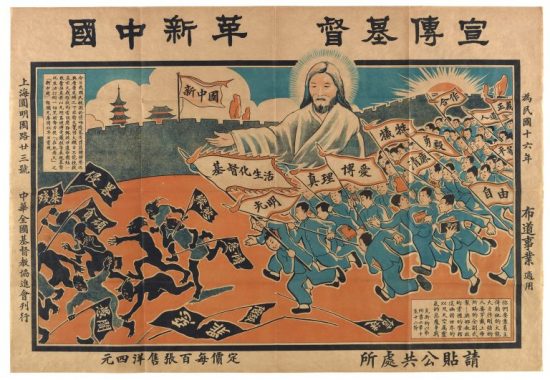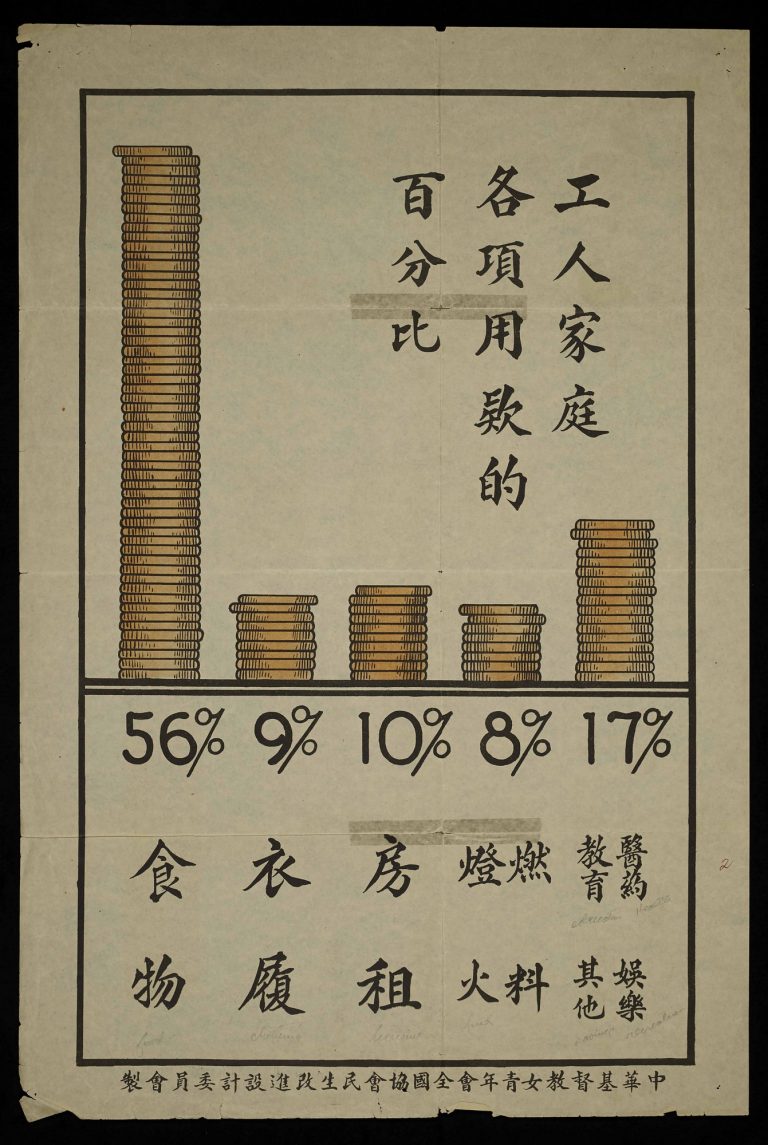Introduction
During the 1920’s, China was divided in a power struggle began between the CCP and KMT. It was during the Republican era, and under Sun Yat-sen’s influence, society underwent some major changes, including the spread of Christianity, the practice of the ideology “Three Principles of the People,” and the resistance of western imperial power after the Revolution of 1911. In this essay, I will be discussing four posters on different themes, analyzing the details of each poster, and the ideas behind them which mainly from the time period 1920s.

Christianity in Republican China
The first poster, published on paper by National Christian Council of China, on the year of 1927, is titled Preach Christ, Reform China. In this image, we can see a group of people dressed in all blue, chasing another group of people who are portrayed as shadowy and devil kind of look. As we can see from this image, Jesus is directing those dressed in blue to drive those shadow people away. The people with blue cloths are holding flags with the words “Justice; Humanity; Cooperation; Equality; Bravery; Sacrifice; Incorruptibility; Freedom; Fraternity; Truth; Christianized life; and brightness.” And those shadow people are holding the black flags, with the words saying: “Laziness; Hedonism; Aggression; Cruelty; Greed; Social Class; Evil; Ignorance; and superstition.”
The background looks like The Great Wall of China, with a huge flag standing in the middle. The flag on the wall has three Chinese characters on it, which means “New China” in English. Since this poster was posted in 1927, which was during Republic of China. Before that, Sun Yet-sun launched the Revolution of 1911. Among the early revolutionists of the Revolution of 1911, Christians were the backbones. Sun Yet- sun was the loyal Christian. As the politician of revolutionary democratism, he advocated Christian religion as the spiritual force of revolution. His Three Principles of the People was the product of combining the Chinese traditional thoughts with the modern western thoughts, the important basis of which was the Christian culture. Therefore, Christianity was spreading in a rapid rate and have had certain influence on people’s daily life during the time of Republic of China. With the historical background of Republican Era, under the leadership of Sun, opened a new era of democratic republic and spread the concept of democratic republic. The top eight characters read from right to left is “Proclaim Christ, Reform China.” We can tell that the society became more and more accepting of Christian culture, especially influenced by it, preaching that China should be reformed under the influence of Christianity during the 1920s. [1]
"Three Principles of the People"
A glimpse through a worker's expenses' distribution


The second poster, published on paper by National Revolutionary Army Headquarters – Office of Politics, with the date unknown, is titled Three Principles of the People. There are three people standing in this image, and from left to right we can tell that they seem to be a student, a military officer, and a civilian/citizen according to the way how they are dressed. The student looking person is tagged with a sign while the other two are holding two signs. These signs are read from left to right are Livelihood of people, Nationalism, and Democracy. And certainly, what these signs indicate is the ideology of “The Three Principles of the People” developed by Sun Yat-sen.
These three people are probably representing the major roles in China’s society during the time when this poster was made. Personally, I would assume that time poster was created during the Republic Era, and most likely from 1920 to 1925. Because after the Revolution of 1911, Sun launched the Three People’s Principles and applied this ideal to Republican society in China. And during the year of 1920 to 1925, the Republic China was at its most prosperous time. The ideas of “Livelihood of people, Nationalism, and Democracy” were advocated and practiced in society, and became a feature of society at the time. [2]
The third poster was published on paper by Civil Development and Design Committee of National Council of the Young Women’s Christian Association, with the date and author unknown. The Chinese written on top right translates as “How the expenses in a worker’s household are distributed,” and these coins are depicted as the percentage of how a worker’s expenses are distributed.
From left to write, the percentage corresponding to things which a worker had spent his money on, translate as: “56% (food), 9% (clothes), 10% (rent), 8% (fuel and light), 17% (education, medicine, entertainment, other).” From this poster, we can tell that the amount of money a worker spent the most was food. This is similar to today’s common people’s distribution of their expenses. However, the rent fee for housing should be higher nowadays in China. Personally, I would say that this poster was created during the Republican era, and most likely from the time from 1912 to early 1920s, because the average annual growth rate of China’s industry was growing at a fast rate during this time, and China’s economy also got better, the system of capitalist economic laws and regulations was preliminarily established. This poster shows that there are less than 20% of money spent on education, medicine, entertainment, and others. From this, we can observe that society was prosperous, and people’s lives were at least more stable than before the 1910s. Only 9% of the total expenses were spent on cloths, which means people weren’t too rich, at least people lived non-capitalist lives, more than half of their expenses were spent on food, and not too much for cloth and entertainments. But still, better than war time and 1910s when revolutions took place in China which caused society to be chaotic back then.
China's attitude towards western imperialism

The fourth poster was posted on paper by the National Union Canton-Hong Kong Strike Committee in the year of 1925, with the author unknown. The top banner says, “The National Laborers’ Union Canton-Hong Kong Strike Committee” with four big Chinese characters under, translate as “Strike Poster.” The three giants who stand in the middle are representing China, India, and Africa from left to right. A text between the banner and the three giants translates to “Imperialism will not able to oppress us when the weak and small nations unite together.”
The poster used India and Africa as examples to tell the Chinese people that imperialism cannot defeat a united weak nation after all. India was colonized by Britain for almost 200 years, and Africa has been colonized and divided by European countries since the Age of Exploration in the fifteenth century. The idea in this poster is similar to Mao Zedong’s support of South American nations in resistance to American imperialism and “Statement by Comrade Mao Tse-tung, Chairman of the Central Committee of the Communist Party of China, in Support of the Afro-American Struggle Against Violent Repression” From A New Storm Against Imperialism. It is obvious that by using countries oppressed by imperialism as examples can resonate with the Chinese people who have been hurt by Western imperialism. Therefore, as a result, it was more effective to make the people feel hatred for imperialism, so that everyone could work together to resist Western forces, which became the social atmosphere at that time.
Footnotes:
[1] Xiaoqun Xu, “The Dilema of Accommodation: Reconciling Christianity and Chinese Culture in the 1920s,” The Historian 60, no. 1 (January 1997): pp. 21-38, https://doi.org/10.1111/j.1540-6563.1997.tb01385.x.
[2]Britannica, T. Editors of Encyclopaedia. “Three Principles of the People.” Encyclopedia Britannica, November 1, 2021. https://www.britannica.com/event/Three-Principles-of-the-People.
